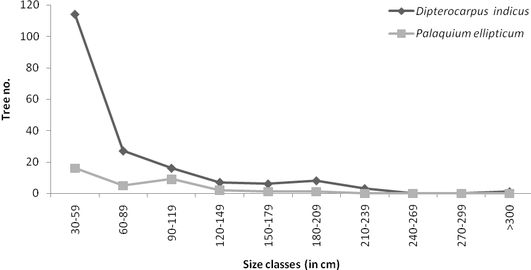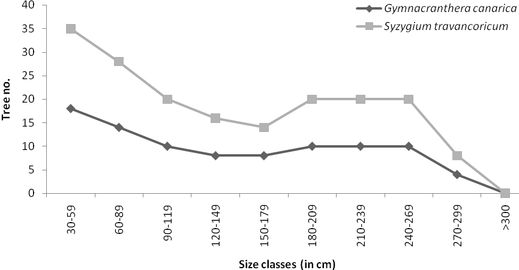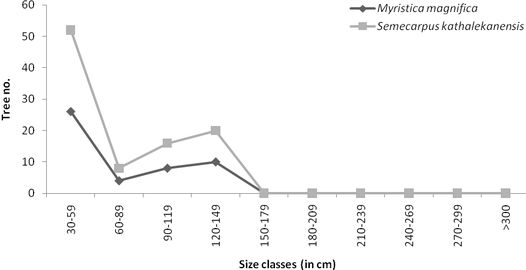Chandran MDS1, Rao GR2, Gururaja KV3, Ramachandra TV4,* Energy and Wetlands Research Group, Centre for Ecological Sciences, Indian Institute of Science, Bangalore 560 012, India E mail: 1mds@ces.iisc.ac.in, 2grrao@ces.iisc.ac.in, 3gururaj@ces.iisc.ac.in, 4tvr@ces.iisc.ac.in |
|
RESULTS AND DISCUSSION Regeneration status Kathalekan is a well established climax forest. Such conclusion has been arrived at from observations on regeneration status, based on the presence of smaller girth classes of notable climax forest trees, which are also relics of the past for the northern latitude of 14°. We have presented in Fig. 14, Fig. 15 and Fig. 16 the girth classes of Dipterocarpus indicus, Palaquium ellipticum, Gymnacranthera canarica, Syzygium travancoricum, Myristica magnifica and Semecarpus kathalekanensis, the species which confer relic status to the Kathalekan forest. The number of individuals in smaller girth classes constitutes the future growing stock for the respective species. All the listed species have satisfactory regeneration, except S. kathalekanensis. The population of this swamp specific species suffered from an attempt made by a local farmer to start a betelnut garden in its habitat. Cause for concern continues for all the swamp exclusive trees, as the swamps themselves are highly threatened habitats, mostly having been converted into agricultural areas in the past (Krishnamoorthy 1960; Chandran and Mesta 2001) Streams and swamps have started drying up in summer because of water diversion for irrigation by few resident farmers. These happenings have reduced the survival chances of the juveniles of swamp exclusives. The juveniles of the flagship relic species, D. indicus, are in good number throughout the forest, including in late successional growth. Absence of forest fires ever since the prohibition of shifting cultivation during the British period, and many mature trees in the relic forest may be considered reasons for its good regeneration. Continued protection of Kathalekan and preventing a couple of resident farmers from putting up bunds across the streams can guarantee regeneration of the scarcer swamp specific trees too. Fig. 14. Girth classes of Dipterocarpus indicus and Palaquium ellipticum Fig. 15. Girth classes of Gymnacranthera canarica and Syzygium trvancoricum Fig. 16. Girth classes of Myristica fatua and Semecarpus kathalekanensis. |




